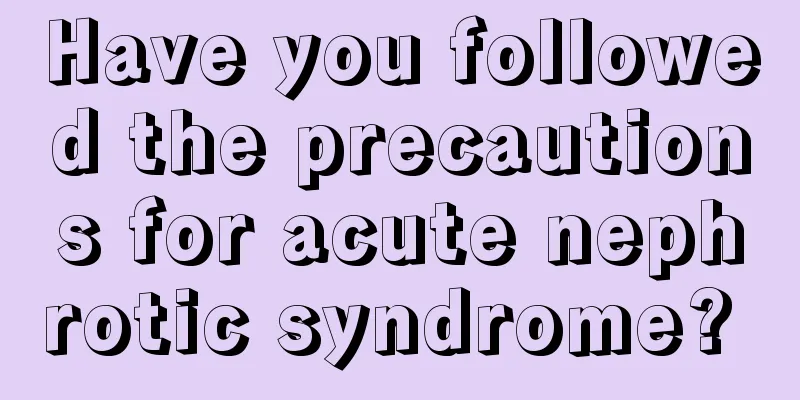Symptoms of angina pectoris, these typical characteristics should be known

|
Angina pectoris is caused by myocardial ischemia. Patients will experience pain in the precordial area. The most typical symptom is pain behind the ribs. Generally, patients with angina pectoris have coronary heart disease, and some patients also have other heart diseases. Angina pectoris must be treated and cared for in a timely manner. 1. Typical symptoms of angina pectoris Typical angina pectoris occurs as sudden pain behind the ribs, mostly in the upper or middle part of the sternum, but can also occur in the precordial area. The pain can radiate to the neck, left shoulder blade, inner side of the left arm to the little finger and ring finger. 2. Nature and duration of angina pain The pain is accompanied by a feeling of heaviness, oppression, and suffocation. A few may even feel like they are dying, forcing the patient to stop moving. The patient becomes pale and breaks out in cold sweats. The pain generally lasts for 1-5 minutes and can be relieved within 1-3 minutes after rest or sublingual administration of nitroglycerin. An angina attack usually does not exceed 5 minutes and rarely exceeds 15 minutes, but variant angina attacks last longer. 3. Atypical symptoms of angina pectoris Headache patients may suddenly experience severe pain on the left side of the head or top of the head, which may last for a few minutes or several hours, and may be accompanied by symptoms such as chest tightness, fatigue, and sweating. From the surface, it looks like vascular neurosis headache or trigeminal neuralgia, but an electrocardiogram may reveal obvious ischemic changes in the myocardium. Toothache mainly manifests as paroxysmal toothache, which is sometimes severe and sometimes relieved by the day. Patients often cannot pinpoint the specific location of the toothache, and dental examinations show no obvious lesions. However, sometimes healthy teeth are mistakenly diagnosed as painful teeth and removed, but the toothache is still felt afterwards. Sore throat angina pectoris is manifested as sore throat, which usually occurs in paroxysmal attacks at night. The doctor's examination of the pharynx and tonsils shows no abnormalities. Patients with hip pain will feel unexplained severe pain in the hip joint, which may be accompanied by profuse sweating or a sense of impending death, but the electrocardiogram manifestations are consistent with the characteristics of angina pectoris. Through angina pectoris treatment, the hip pain will be relieved. Patients with lower limb pain may experience severe pain in one or both lower limbs, which may radiate to the right groin or right toes. It is easily misdiagnosed as sciatica and can be relieved by rest or taking anti-anginal drugs. 4. Tips Typical angina pectoris is not difficult to identify, and the pain is mostly located behind the ribs or in front of the heart. However, the symptoms of these special atypical angina pectoris are complex and varied, and should arouse extra vigilance. |
<<: Are big eye bags a sign of kidney deficiency? Causes of eye bags
>>: What is missing from beriberi? Causes of beriberi
Recommend
How to remove chewing gum from clothes?
Speaking of chewing gum, everyone must be familia...
What is the daily care for gallbladder cancer
The rehabilitation care for patients with gallbla...
What methods can be used to treat lung cancer? The best treatment methods for lung cancer
The incidence of lung cancer is relatively high n...
How is shoulder dislocation reduced by manipulation?
Our interosseous parts, and the joints connected ...
What are the current liver cancer screening items?
Liver cancer is a malignant tumor disease that is...
Disadvantages of rice wine
Drinking table culture is a part of Chinese cultu...
What are the benefits of moxibustion on the ovaries?
If women want to maintain their ovaries, they mus...
What are the dangers of dream spirits
When men enter puberty, their genitals will devel...
Can hydrogen peroxide be consumed?
We have all heard of hydrogen peroxide, which is ...
How to provide psychological care for lung cancer patients? How to care for lung cancer patients in daily life
Patients with lung cancer usually have abnormal a...
The accuracy of bronchoscopy in lung cancer diagnosis
Accuracy of bronchoscopy in detecting lung cancer...
Will benign bone cancer recur after resection
Will benign bone cancer recur after resection? It...
Is the recurrence rate of ovarian tumor high?
Ovarian tumor is a stubborn disease that affects ...
What are the pain relief treatments for advanced pancreatic cancer?
Speaking of pancreatic cancer, this is a malignan...
What is the best way to treat onychomycosis? Home remedies to treat onychomycosis
Everyone should know that onychomycosis is contag...









